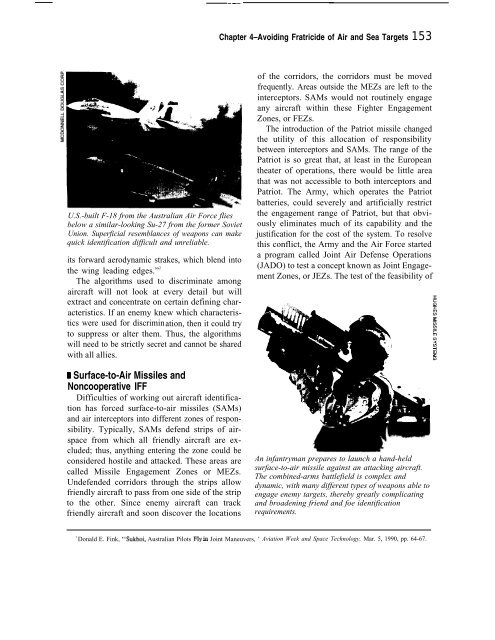Who Goes There: Friend or Foe? - Federation of American Scientists
Who Goes There: Friend or Foe? - Federation of American Scientists
Who Goes There: Friend or Foe? - Federation of American Scientists
You also want an ePaper? Increase the reach of your titles
YUMPU automatically turns print PDFs into web optimized ePapers that Google loves.
—.——<br />
U.S.-built F-18 from the Australian Air F<strong>or</strong>ce flies<br />
below a similar-looking Su-27 from the f<strong>or</strong>mer Soviet<br />
Union. Superficial resemblances <strong>of</strong> weapons can make<br />
quick identification difficult and unreliable.<br />
its f<strong>or</strong>ward aerodynamic strakes, which blend into<br />
the wing leading edges.” 2<br />
The alg<strong>or</strong>ithms used to discriminate among<br />
aircraft will not look at every detail but will<br />
extract and concentrate on certain defining characteristics.<br />
If an enemy knew which characteristics<br />
were used f<strong>or</strong> discrimination, then it could try<br />
to suppress <strong>or</strong> alter them. Thus, the alg<strong>or</strong>ithms<br />
will need to be strictly secret and cannot be shared<br />
with all allies.<br />
~ Surface-to-Air Missiles and<br />
Noncooperative IFF<br />
Difficulties <strong>of</strong> w<strong>or</strong>king out aircraft identification<br />
has f<strong>or</strong>ced surface-to-air missiles (SAMs)<br />
and air intercept<strong>or</strong>s into different zones <strong>of</strong> responsibility.<br />
Typically, SAMs defend strips <strong>of</strong> airspace<br />
from which all friendly aircraft are excluded;<br />
thus, anything entering the zone could be<br />
considered hostile and attacked. These areas are<br />
called Missile Engagement Zones <strong>or</strong> MEZs.<br />
Undefended c<strong>or</strong>rid<strong>or</strong>s through the strips allow<br />
friendly aircraft to pass from one side <strong>of</strong> the strip<br />
to the other. Since enemy aircraft can track<br />
friendly aircraft and soon discover the locations<br />
Chapter 4–Avoiding Fratricide <strong>of</strong> Air and Sea Targets 153<br />
<strong>of</strong> the c<strong>or</strong>rid<strong>or</strong>s, the c<strong>or</strong>rid<strong>or</strong>s must be moved<br />
frequently. Areas outside the MEZs are left to the<br />
intercept<strong>or</strong>s. SAMs would not routinely engage<br />
any aircraft within these Fighter Engagement<br />
Zones, <strong>or</strong> FEZs.<br />
The introduction <strong>of</strong> the Patriot missile changed<br />
the utility <strong>of</strong> this allocation <strong>of</strong> responsibility<br />
between intercept<strong>or</strong>s and SAMs. The range <strong>of</strong> the<br />
Patriot is so great that, at least in the European<br />
theater <strong>of</strong> operations, there would be little area<br />
that was not accessible to both intercept<strong>or</strong>s and<br />
Patriot. The Army, which operates the Patriot<br />
batteries, could severely and artificially restrict<br />
the engagement range <strong>of</strong> Patriot, but that obviously<br />
eliminates much <strong>of</strong> its capability and the<br />
justification f<strong>or</strong> the cost <strong>of</strong> the system. To resolve<br />
this conflict, the Army and the Air F<strong>or</strong>ce started<br />
a program called Joint Air Defense Operations<br />
(JADO) to test a concept known as Joint Engagement<br />
Zones, <strong>or</strong> JEZs. The test <strong>of</strong> the feasibility <strong>of</strong><br />
An infantryman prepares to launch a hand-held<br />
surface-to-air missile against an attacking aircraft.<br />
The combined-arms battlefield is complex and<br />
dynamic, with many different types <strong>of</strong> weapons able to<br />
engage enemy targets, thereby greatly complicating<br />
and broadening friend and foe identification<br />
requirements.<br />
2<br />
Donald E. Fink, “Sukhoi, Australian Pilots Fly in Joint Maneuvers, ’ Aviation Week and Space Technology, Mar. 5, 1990, pp. 64-67.
















